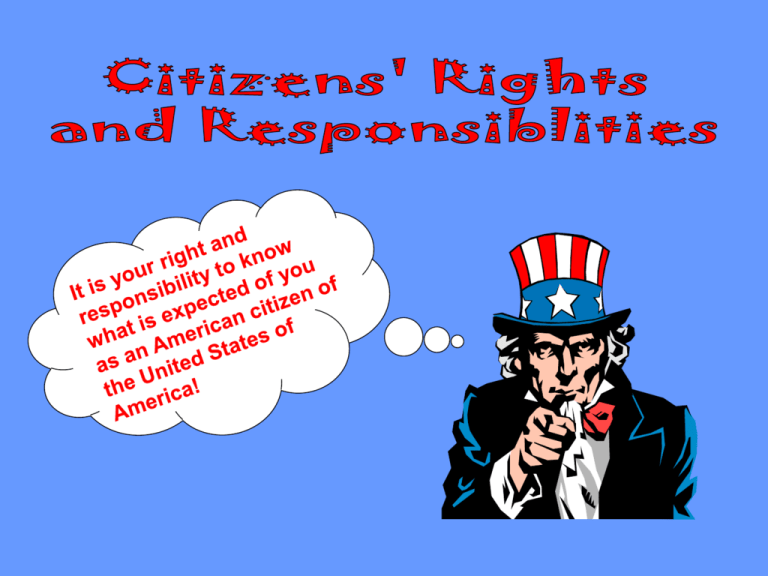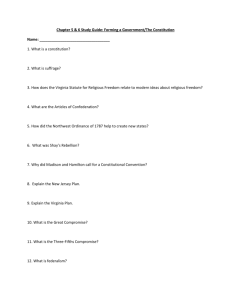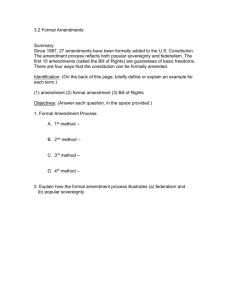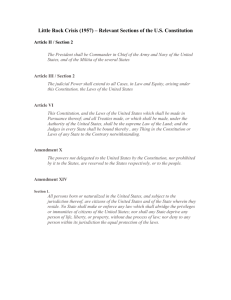File how we organize ourselves ppt 15-16
advertisement

*5 minutes- Post-It
Notes- Number Heads…
1s- Post-It Notes (5 min.)- How can
you be a responsible citizen?
2s- Write any questions you have
about your rights and responsibilities
as a student in this school and
country. Stick on Wonder Wall.
Why Do I Need to Learn This
Material???
• SS5CG1: The student will explain how a citizen’s rights
are protected under the U.S. Constitution.
• Explain the responsibilities of a citizen
• Explain the freedoms granted by the Bill of Rights
• Explain the concept of due process of law
• Describe how the Constitution protects a citizen’s rights
by due process
• SS5CG2: The student will explain the process by which
amendments to the U.S. Constitution are made.
• Explain the amendment process as outlined in the
Constitution.
More StandardS…
• Describe the purpose for the amendment
process.
• SS5GC3: The student will explain how the
amendments to the U.S. Constitution have
maintained a representative democracy
• Explain the purposes of the 12th and 17th
amendments.
• Explain how voting rights were protected by the
15th, 19th, 23rd, 24th, 26th
Lesson One
Essential Question:
How are a citizen’s rights protected under
the U.S. Constitution?
Vocabulary:
responsibility, citizen, Bill of Rights,
Constitution
Think about this…Did you know that we act as
responsible citizens in many ways everyday?
Have you ever recycled soft drink cans?
Have you ever voted for a class officer (student council)?
Do we vote for Golden rule?
Note-taking Guide
• Use your note-taking guide as we
watch the PowerPoint, and fill in the
information as you learn it.
Who are U.S. Citizens? What are
Their Rights and Responsibilities?
A citizen is a person who has all the rights
and responsibilities of belonging to a
nation.
Rights: All people born in the US are
automatically US citizens. If a baby is
born in another country, but
one or both of the parents are
US citizens, the baby is also
an American citizen.
Citizenship has responsibilities, or duties, as well as rights.
Some duties, such as voting are voluntary, meaning citizens can
choose whether or not they want to do them.
Other responsibilities are obligations, meaning citizens must do
them or be punished under the law.
The legal obligations of citizens include obeying laws, paying
taxes, serving on juries, and, for men, registering for military
service.
Responsible Citizens
The Constitution and Bill of Rights
The plan for the US government is described in the
Constitution of the United States of America.
The US Constitution was written in 1787. Nine out of 13
states ratified (or accepted) it in June 1788.
It became the law of the land in March 1789, after it had been
ratified by 9 of 13 states.
The US Constitution describes the powers held by
government. It also lists the powers that the federal
government does not have.
Finally, it describes how the federal
government is organized.
The Scene at the Signing of the Constitution of the
United States , painted by Howard Chandler Christy in
1940. It depicts the signing of the U.S. Constitution at
Independence Hall in Philadelphia, Pennsylvania.
The Bill of Rights
The Bill of Rights is
the first ten
amendments to the
Constitution. It
gives certain rights
and freedoms to all
citizens.
Watch Bill of Rights
on thumb drive
(about 3 minutes).
Discuss the following question.
Which of the following is one of the
duties of citizenship?
A.
B.
C.
D.
Reading many books
Visiting national parks
Voting in elections
Watching candidates speak
Responsible Citizens
Let’s Vote on a Class
Project!
• Organize a class project
to implement during a
one-week period. For
Example: campus cleanup, food drive for the
needy, or start a recycle
box for pencils.
• Make posters to advertise
your project and display
throughout the school.
Responsible Citizens: Extending and Refining Activity
Extra Credit- Research someone who has made
an incredible difference in our society, and write
an informational essay on it to report to
the class.
Summarizing Strategy: 3-2-1
• Name three characteristics of a responsible
citizen.
• Name two ways people can demonstrate
responsible acts.
• Connection: What is one way that our classroom
essential agreements are like the Bill of Rights?
• Watch The American Government on thumb
drive (15 minutes).
Lesson 2
The ABC Guide to the Bill of
Rights
Partner Talk
Tell your partner what you know
about the Bill of Rights.
Watch The Bill of Rights
on thumb drive (about 2
minutes).
The Bill of Rights
The Bill of Rights is
the first ten
amendments to the
Constitution. It
gives certain rights
and freedoms to all
citizens.
Here’s a way to remember the
first 10 amendments (Bill of
Rights)…
First Amendment
• Grants the freedom of religion, speech,
press, gathering together (assembly),
and the right to gather signatures about
issues and sent them to the
government(petition). How many letters
are in apple?
• 1st Amendment-A for apple (there are 5
letters in “apple” just like there are 5
basic freedoms granted in the 1st
Amendment: 1. freedom of speech 2.
freedom of religion 3. right to assemble 4.
right to petition 5. freedom of the press)
Second Amendment
• Grants the right to keep and carry
weapons, or arms.
• 2nd Amendment- B for banana (banana
looks like a gun- you have the right to own
and carry weapons)
• OR B for bear- (you have the right to
bear arms or weapons)
Third Amendment
• Protects people from having the military
stay in their homes.
• C is for couch: (you don’t have to allow
soldiers to stay in your house and sleep on
your couch)
Fourth Amendment
• Protects people from being searched and
having things taken from them, or seized,
without having a warrant first (a letter from
the judge giving them permission)
• D is for dog, policeman (and police dogs)
can’t search/sniff or come into your house
without a warrant
Fifth Amendment
• Gives every citizen the right to due
process of law.
• E for excuse- (you don’t have to provide
an excuse for a crime you have
committed because whether or not you are
guilty, you are DUE a process/trial by jury.
• Also, E is for even. Even the government
has to follow the same laws as the
citizens.
• See next slide for more information on
this very important amendment!
Fifth Amendment
The Fifth Amendment gives every citizen the right to the due
process of law.
The law must be followed by the government as well as by
citizens.
It also says that people cannot be brought to trial twice for the
same crime, which is called double jeopardy.
The Fifth Amendment also protects people from having to speak in
court about themselves. When people refuse to speak in court,
it is called “taking the fifth”.
It also says that the government cannot take property without
paying for it. The power of the government to take property is
called eminent domain.
More on Due Process of Law
Due process is the idea that the way the government uses the
law has to be fair and that every person is under equal law. The
government has to follow the law just like citizens do.
Due process protects people from the government. In other
words, you are DUE a PROCESS! Protection from government
is something that the framers, or writers, of the Constitution
thought about a lot. Can you make a connection? Do you
remember why?
The American colonists did not have protection from the British
government. They had to fight a war against the British
government to protect their rights.
Sixth Amendment
• Gives people accused of a crime the right
to a speedy trial.
• F for fast (you have the right to a “speedy”
trial; your trial must take place in a
“speedy” manner)
Seventh Amendment
• Gives the right to a civil trial by jury.
• G for gate (you have the right to a trial by
a jury- jury sits behind a “gate”- the rail
that a jury sits behind in the courtroom)
Eight Amendment
• Protects people from cruel and unusual
punishment by the government.
• H for horrific, or H for horse (long ago
people were quartered {pulled apart into 4
different pieces} using horses)
Ninth Amendment
• Guarantees that people have many
rights, even ones that are not written in
the Constitution.
• I for inside (The Bill of Rights in the
Constitution has 10 amendments, but
there are also other amendments/rights
that are not INSIDE the Constitution {and
not mentioned in the Bill of Rights})
Tenth Amendment
• Says that any power not given to the
federal government is given to either the
state or to the people.
J for jigsaw (A jigsaw puzzle is made up of
individual pieces. Some laws are
reserved for the individual states, but all
the states come together like a puzzle.)
Do Students Have Rights?
Discuss this with a neighbor.
Watch Student Rights on
www.brainpop.com.
Assignment
• Pass out Bill of Rights ABC sheet.
• Option 1: Rewrite the amendment in “KidFriendly” language on a poster. Draw a
picture to go along with the amendment
and post in the classroom. Be sure to
include the mnemonic device that you will
use to remember it.
• Option 2: Create a 2-3 minute skit to
present to the class which explains and
shows the importance of the amendment
you choose(must write the skit on paper
first).
Writing Assignment for Friday- Opinion
Writing
Option 1: Which amendment from the
Bill of Rights do you think is most
important? Give evidence from the
resources we have used to support
your opinion.
Option 2: How would the world be
different if we didn’t have the
amendments that we discussed in the
Bill of Rights?
Lesson 3- Let’s review the Bill of Rights on
http://www.brainpop.com/soci
alstudies/usgovernmentandla
w/billofrights/
Lines of Inquiry:
How are amendments to the U.S. Constitution made?
How has the amendment process to the U.S. Constitution
maintained a representative democracy?
Time Permitting: Roles of the Bill
of Rights and the Constitution
Rewriting the Bill of Rights in
“Kid-Friendly” Language Group Activity
• Work with your partner/partners to rewrite an
amendment to the Constitution, while
providing an illustration as to what the
amendment means.
How the U.S. Constitution Can Be Amended
The Framers of the Constitution knew that over time, the document might
But, they thought that it should not
be changed too often. The process that they
created for amending the Constitution makes it
possible, but not easy, to do.
need to be changed.
Article V (or 5) of the Constitution creates the process for making
amendments. The first step is to propose, or suggest, the amendment.
Two-thirds of the Senate and two-thirds of the House of Representatives
have to vote for the proposed amendment to put it into the ratification, or
approval, process.
The proposal is then sent to the governors of every state. The state
legislature then votes on ratification of the new amendment. As soon as
the proposal has been ratified by three-quarters of the states (38 states
total), it becomes an official amendment to the Constitution.
Flow Chart: How a Proposed Congressional
Bill Becomes an Amendment
1. The bill to amend the
Constitution may originate in
Congress.
2. The bill must first be approved by a
2/3 vote in both the U.S. Senate and
the House of Representatives.
3. Once approved by Congress, the
proposed bill passes to the states. If
approved by 3/4 of all state legislatures,
it becomes a Constitutional amendment.
It must be noted that at no point does the President have a role in the
formal amendment process (though he would be free to make his opinion
known). He cannot veto an amendment proposal, nor a ratification. This is
clear in Article 5 of the United States Constitution
Amendment Process Summarized
Proposal Process
Two-thirds of Congress
or convention called
by two-thirds of state
legislatures
Ratification Process
Three-quarters of state
legislatures
Let’s review the Constitution on
http://www.brainpop.com/socialstudies/ushi
story/usconstitution/
Groups, tell me more about:
Part One of Lesson
United States motto
“E pluribus unum”
is one motto of the
United States. This
phrase means “out of
many, one”. This
motto is a reminder
that the original
thirteen colonies
formed one country.
It can be found on
our American coins.
Some Extra Information If Needed!
•
•
•
•
•
The Election of a President
The Election of Senators (GPS)
The Election of Representatives
The Electoral College Website
Presidental Election Brain Pop







